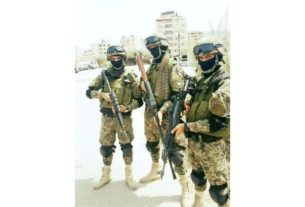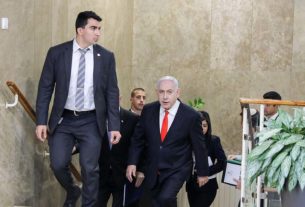TEL AVIV ((JEWISH REVIEW)) — On Monday morning, Roxane Runel posted a photograph to Instagram of two Israel military officers addressing a crowd of reporters in an auditorium. Behind them is a giant television screen.
“Press conference between the international media and the Israeli army after it disseminated images and recordings of the Oct. 7 attacks,” Runel, a reporter for France’s M6 television channel, wrote across the photo, touting an upcoming broadcast. “Why? What is at stake?”
Runel, who has reported from several countries, has already interviewed relatives of Israeli hostages held in Gaza after Hamas’ Oct. 7 invasion of Israel, which killed and wounded thousands. Yet in the middle of Monday’s screening of the attack footage, she was one of a number of journalists who stepped out early.
“It was too much,” she told the Jewish Telegraphic Agency. “I knew coming here that the hardest thing for me would not be the images but the sound, because you can close your eyes if the images are too much.”
Runel was one of about 200 journalists who attended the screening, which the Israeli government billed as raw and unedited audio and video taken from Hamas terrorists’ body cameras and phones as they massacred communities on Israel’s border with Gaza. In addition to clips of Hamas attackers shooting people, the 43-minute compilation contained graphic images of children being murdered, bodies burned, civilians being mowed down and other atrocities.
Gruesome photos and videos have circulated online in the two weeks after the attack, along with harrowing accounts of the violence visited upon Israelis. The images have become so ubiquitous that Jewish day schools in the United States cautioned students to delete their social media apps to avoid seeing them, while journalists and other public figures have expressed ambivalence about sharing them.
The IDF has taken delegations of foreign journalists into some of the hardest-hit communities, with one spokesperson saying just days after the attack, “Walking through here is like Eisenhower walking through Bergen-Belsen and seeing the destruction and carnage. The world needs to witness this firsthand.”
Now, the Israeli government’s decision to broadcast the footage came as it is increasingly concerned that people are questioning the scale and depravity of Hamas’ massacre. Social media users and journalists alike have expressed skepticism about widespread reports and testimonies of the attack’s most harrowing details, often at the same time as they have sought to shift attention toward the escalating casualties of Israel’s retaliatory war in Gaza, where it aims to depose Hamas.
“I can’t believe I’m saying this and I can’t believe that we as a country are having to do this,” said Eylon Levy, an Israeli government spokesman, in a video announcing the press conference. “As we work to defeat the terror organization that brutalized our people, we are witnessing a Holocaust denial-like phenomenon evolving in real time as people are casting doubt on the magnitude of the atrocities that Hamas committed against our people, and in fact recorded in order to glorify that violence.”
At the press conference, held at a military base north of Tel Aviv, chief IDF spokesperson Adm. Daniel Hagari said the military had “been thinking about this for a couple of days, whether to show it or not,” but decided that screening the footage served as a valuable reminder of the atrocities both for the international media covering the war and Israelis themselves.
“We will not let the world forget who we are fighting,” he said, adding that the footage helps Israelis “to understand ourselves what we are fighting for.”
In addition, IDF Maj. Gen. Mickey Edelstein told the reporters, the Israeli military has evidence it cannot show of sexual violence committed by the Hamas terrorists as well as evidence of links between Hamas and Iran.
He dispelled Hamas claims that terrorists unaffiliated with the group committed the atrocities, saying that the video shows proof that “the vast majority are Hamas” and that the perpetrators attacking civilians were dressed in full tactical gear. Written and other evidence the IDF has discovered, he added, shows that Hamas had planned “to bring hostages and keep families, in order that it would be much more painful.”
Many attendees gasped in horror at difficult elements of the footage, and some chose to exit the theater before the screening had finished. Runel said her personal “limit” was reached when listening to an audio clip of a call on WhatsApp between a Hamas terrorist and his parents, made via the stolen cellphone of an Israeli victim.
“He tells them on the phone — with a voice that is so ecstatic — he sounds like he’s out of his mind,” she said. “He was repeating the same thing over and over again, ‘I killed 10 of them.’ He was saying this as something he was really proud of and he wanted his parents to check the Whatsapp” to see videos he sent of the massacre. The man’s father reacted with praise, while his mother begged him to return home.
Amit Palit, a news anchor and correspondent for India TV based in New Delhi, said that after reporting on the attacks of Oct. 7 on live television, seeing the raw footage helped him understand the “bigger picture.” He said the screening “was necessary for many people who have some doubts.”
Palit, who has been covering the war in Israel for the past 12 days, was most affected by a video of two young brothers after they lost their father, who was murdered in front of them with an explosive while the three were hiding together in a bomb shelter at home. The footage was among the “very painful” clips he witnessed, he said.
“He was asking, ‘Dad,’ and the teenager said, ‘Why am I alive?’” Palit recounted. “A 13-year-old boy cursing himself, asking why he was alive, asking his brother ‘Can you see?’ And he couldn’t see because he lost [one of] his eyes” from the shrapnel of the blast that killed his father.”
Some journalists expressed skepticism about the screening, saying that authentic footage compiled by the Israeli army could come with its own agenda. Nicolas Coadou, a reporter for BFN TV in France, said the footage “is edited, they choose what they want to show us.”
But he acknowledged that reporting on the press conference would be challenging.
“I have a live [broadcast] in one hour,” he said. “And I don’t know what I am going to say.”




